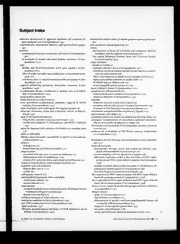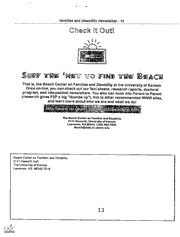
ERIC ED411661: Family-Centered Service Delivery. PDF
Preview ERIC ED411661: Family-Centered Service Delivery.
DOCUMENT RESUME EC 305 854 ED 411 661 Higgins, Cindy, Ed. AUTHOR Family-Centered Service Delivery. TITLE Kansas Univ., Lawrence. Beach Center on Families and INSTITUTION Disability. National Inst. on Disability and Rehabilitation Research SPONS AGENCY (ED/OSERS), Washington, DC. ISSN-1044-8217 ISSN 1997-00-00 PUB DATE NOTE 13p. H133B3007-95 CONTRACT Beach Center on Families and Disability, 3111 Haworth, AVAILABLE FROM University of Kansas, Lawrence, KS 66045; telephone: 785-864-7600; World Wide Web: http://www.lsi.ukans.edu/beach/beachhp.htm Serials (022) PUB TYPE Collected Works Families and Disability Newsletter; v8 n2 Sum 1997 JOURNAL CIT MF01/PC01 Plus Postage. EDRS PRICE American Indians; Cultural Awareness; Delivery Systems; DESCRIPTORS *Disabilities; *Early Intervention; Family Attitudes; Family Involvement; *Family Needs; *Family Programs; *Integrated Services; Preschool Education; *Staff Role; Young Children Kansas; North Carolina; Project Head Start IDENTIFIERS ABSTRACT This theme issue focuses on family-centered practices and policies for service delivery. The first article, "Family-Centered Service Delivery," reports on a study of 130 published sources in education, social work, nursing, psychology, occupational therapy, and related disciplines, which found that the key components of family-centered philosophy and (1) focusing upon the family as the unit of attention; practice were: (2) (3) organizing assistance in organizing assistance collaboratively; (4) considering family accordance with each individual family's wishes; (5) addressing family needs holistically; (6) individualizing strengths; (7) giving families complete information in a supportive family services; (8) normalizing perspectives; and (9) structuring service delivery to manner; ensure accessibility, minimal disruption of family integrity, and routine. Another article, "Measuring Family-Centered Practices," details the findings of a survey of 443 parents of children with disabilities that found the three most desired early intervention staff behaviors were listening to families, treating families with respect, and accepting families as important team members. A third article "Family-Centered Statutory Policy," discusses findings from a study that evaluated family-centered statues in North Carolina and identified 24 quality indicators of exemplary family-centered legislation. The newsletter also describes a Head Start program for Native American children and strategies that staff can use to use it with families. (CR) ******************************************************************************** Reproductions supplied by EDRS are the best that can be made from the original document. ******************************************************************************** PERMISSION TO REPRODUCE AND THE UNIVERSITY OF KANSAS I DISSEMINATE THIS MATERIAL HAS BEEN GRANTED Beach Center on BY Families and Disability TO THE EDUCATIONAL ) RESOURCES INFORMATION CENTER (ERIC) == rtes Fa ByC Family-centered service Focusing upon the family as In the former medical way of delivery, across dis- delivering health care services, the unit of attention ciplines and settings, professionals looked only at the Organizing assistance collab- recognizes the centrality child, not the family. Then they oratively (e.g., ensuring mutual of the family in the lives of told the family what to do. End of respect and teamwork between individuals. It is guided by story. Today, demand for family- team workers and clients) fully informed choices centered practices has evolved Organizing assistance in accor- made by the family and from the old service delivery style. dance with each individual focuses upon the Family-centeredness, known family's wishes so that the strengths and capa- also by names such as family-fo- family ultimately directs deci- bilities of these families. cused, family-oriented, family ref- sion making erenced, and family empowerment, Considering family strengths reflects the words of poet Maya Family-centered care providers (versus dwelling on family de- Angelou: "At our best level of ex- acknowledge that each family ficiencies) istence, we are parts of a family, member influences the family as a Addressing family needs holis- and at our highest level of whole. To separate one from an- tically (rather than focusing on achievement, we work to keep the other is like trying to put together a member with a "problem") family alive." Individualizing family services a puzzle without all the pieces. Family-centered practices and The child's behavior, characteris- Giving families complete infor- policies are not restricted to the mation in a supportive manner tics, and resources influence other health care or disability fields. Normalizing perspectives (i.e., family members and vice versa. Social work, education, psychol- recognizing that much of what As social work educator M. L. ogy, sociology, and occupational those receiving services are Allen said, "For most children in therapy also are embracing this experiencing is typical) this country, the best investment form of service provision. Structuring service delivery to in their future is an investment in By trying to give families what ensure accessibility, minimal a strong family." they want, professionals facilitate disruption of family integrity families' own power. and routine If It Works...3 Key components. After re- Scale Research Brief...4 A new definition. Upon Program Indicators...5 viewing 130 published sources in completion of the literature re- Tuning in to Families...6 education, social work, nursing, view and consultation with fam- Policy Brief...7 psychology, occupational therapy, ilies and service agencies across Statute Indicators...9 and related disciplines, Beach Beach Products...10 the United States, Beach Center Center researchers found these key Beach Center Update..11 researchers came up with the components of family-centered Check It Out...12 following definition: philosophy and practice: L16.4111.4- FOUCADON U S OEPOIMENT Oftc. 4* ca.cocor e'"""°""LCE.7RES"01 tE C1-5Rcrr-°n" 0 Idine, charge Ma Pon mad. lo Wpm. reproaxbo. Pah' Rafts ol viva. et opinionS gado!. or 0* do not naomarily rep* ofti.1 OEM pe p PA." Fam500es and DOsabigOtv HeuggetteT - 2 Family-centered service pro- nurses-- also have done much to Over the last 20 years, family- viders try to address all challenges increase family-centered services centered services have developed that may influence children who in the last 25 years. Other health significantly in special education, need care. Often that means that early childhood education, and the the service provider works with developmental disabilities fields--. other agencies to provide "wrap- largely because of federal legis- "We w0[10 be [Dann' around" care, an all-in-one pack- lation encouraging parental in- emapped to age of assistance. volvement in service delivery. answerr a qamny's Strengths. Family-centered enefits of family-center- needs professionals look hard for the edness. Family-centered prac- strengths--the talents, resources, nstenv vea00v tices can improve: attributes, and aspirations--of each 00sten to w[Tat Child functioning family member. Who knows better Mau a[fQa sayOng." Parent skills and about a person than his or her fam- emotional well-being Albert Gore, Vice- ily? Family centeredness values Parents' view of service President of the parental knowledge and experi- effectiveness and sense of ence. The service provider be- United States comes a consultant who provides control over their child's care families with information that Problem solving strengthens them to make their Ability of families to care own decisions. Family-centered professionals have followed their for their child at home service delivery makes the most of lead. Service delivery family involvement in decision The consumer movement out of Cost-effectiveness making. Information is actively the 1960s, legislation, increased Family empowerment shared. Everyone who is signifi- demand for complex chronic ill- cantly involved with the child col- ness services, and rising health While there are many bene- laborates in final decisions. Ulti- care costs have pushed the rest of fits, however, family-centered mately, the family should make medicine toward family-centered the final decisions. delivery practices. service delivery can be chal- lenging to practice. Educators have Family centeredness also has History. Interestingly, the term long been linked with social work. suggested that obstacles to family family-centered was coined in the centeredness include profession- As one social worker wrote in 1950s by the Family-Centered als' lack of training in counseling 1917, "As society is now or- Project of St. Paul, Minnesota, ganized, we can neither doctor and family systems, role clarity, which formed much current flexible funding, and inclusive people nor educate them, launch thought about working with services not provided by the them into industry nor rescue them families facing multiple chal- from long dependence, and do school or community. Yet, service lenges. Those in the medical providers must meet these chal- these things in a truly social way field--family practitioners, ob- lenges if they are to fulfill their without taking their families into stetricians, pediatricians, and account." professions' stated values. Families and Disability (ISSN: 1044-8217) is published Department of Education, Office of Special Education three times a year by the Beach Center on Families and and Rehabilitative Services, Grant #H133B3007-95. Disability at The University of Kansas. There is no Opinions expressed in Families and Disability do not subscription charge. Funding for Families and necessarily represent the view of NIDRR or The Disability is provided by the National Institute on University of Kansas. Copyright 1997. Disability and Rehabilitation Research, U. S. Editor: Cindy Higgins swelettev a S Families and DisabOrli S El E/ beautiful quilt on the wall, which I This particular place I went was a asked about. They told me the star Head Start program. Head Start is points represented tribes within a program that has a strong history their tribe and other meaningful of family involvement. They just were interested in getting feedback elements. They knew I was inter- ested in learning about them. about how well they were doing. "Because families live on a "The Ogala Sioux feel people have to learn their customs to stay reservation, travel is a real prob- there and work. If not, people lem. It is a gigantic reservation. People often have to drive over an come in with the idea of change, hour to get to the program facili- instead of accepting the way things ties from the nearest city or out- are on the reservation. "They have people come in post. You drive, then--all of a Beverlyn Brown, Beach Center researcher, has given several workshops on the sudden--here are three buildings: a who can't speak their language, Family-Centered Behavior Scale. Here, mental health center, dialysis can't communicate, don't want to Bever 1yn discusses her workshop learn, and then end up leaving. building, and Head Start. experiences and family -centered services. Families have to start from ground "Because of distance then, they "When I went to do training on have to deliver services in a spe- one again. This ruins service conti- family centeredness, I didn't go to cific place and have restraints on nuity. evaluate programs. I told them "I didn't go in there telling hours for people to come. They what family-centeredness is and can't go to families. But they do them what to do or what they how they could look at their own provide transportation to their needed to be doing. I also tried to organizations. They then could building. Even though these fac- be aware of the difference between self-identify how family-centered tors make the program center- my culture and theirs to see how they were by using the Family- based, parents, when asked, said my training materials and presen- Centered Behavior Scale and they viewed the services as family tation would fit. Sometimes you knowledge they gained from the centered. have to change the materials to training. "Cultural competency is impor- help families get services deliv- "Some organizations are doing tant in family-centered service ered to them in the way they want. FC-things, some not. Most pro- provision. At the reservation, the "On the reservation, I did two grams look at certain parts of their majority of social workers are Na- trainings on family-centered ser- organization and practices, rather tive Americans who went away to vice delivery. One in the morning, than the whole. school and came back. They un- the other in the afternoon for a to- "One family support program I derstand their people. tal of 30 staff members. went to was family-centered in "Those who were not Native "In these trainings, I presented many respects, but the service pro- American had to learn Sioux cus- the key element of family-cen- viders couldn't get their adminis- toms to be really accepted. They teredness and invited them to dis- tration to listen. They wanted me had to come to work willing to cuss their work with families, at there to speak to them and the learn. There was a doctor there both the case and organizational administrators, so the adminis- who now can speak the language levels. They change things to fit tration could hear what they had to of the Ogala Sioux more fluent them, which works for them. say about meeting the needs of than some of the younger Native Evaluations indicated that the children and families better. Americans on the reservation. I training stimulated staff members "My favorite training was with also really wanted to know about to view their work in new ways. the Oglala Sioux in South Dakota. them. For instance, they had a They were doing an excellent job." 4 Hies and Disability Newsletter - 4 F d Practices Measuring Family-Center consistency over time. Most sur- services in Arizona. It has also vey respondents were women been recommended for adoption in Family-Centered (87%), white (68%), and living in a national evaluation of children's Behavior Scale two-parent households (72%). Par- health systems change initiatives." Who: 443 parents/caregivers What: The development of a ticipants had children with devel- To obtain the Family-Centered tool that programs can use to opmental delay (34%), mental re- Behavior Scale, contact the Beach measure their family- tardation (32%), emotional or be- Center on Families and Disability, centeredness havioral disorder 7(29%), or learn- 3111 Haworth, University of Kan- When: 1994-1995 ing disability (29%). sas, Lawrence, KS 66045. Cost is Where: The Beach Center on The three most desired staff $35.00 and includes a camera- Families and Disability behaviors (according to families) ready copy of the Scale in English Relevant Findings: The three were: listening to families, treating and Spanish, a manual, and back- most desired staff behaviors families with respect, and accept- ground information on the scale (according to families) were: ing families as important team and family-centeredness. All or- listening to families, treating members for a child. ders must be prepaid. families with respect, and Families appreciated staff who accepting families as important did not judge families because of team members for a child. The differences, did not blame parents Family-Centered 1991 was Program Rating Scale de- for their children's behavior, and To develop a scale that service signed to evaluate early inter- did not criticize what parents do vention programs. Extensive delivery providers could use to with their children. field testing at 56 early interven- measure their own family-centered Families, according to the tion programs states in 10 practices, Beach Center research- scale, least often received help showed that parents and staff ers first reviewed existing litera- had similar opinions about the from service delivery staff access- ture, then defined family-cen- importance of program features, ing support from other families, including: Flexibility and innova- teredness based on their findings. friends, and community. tion, providing responsive ser- This project grew out of an earlier On all items, staff members vices, individualizing services, Beach Center scale that focused on providing practical information, whom participants rated "best" early intervention programs [see communication style, maintain- received higher family-centered ing comfortable relationships, box]. Two groups, (1) parents who scores than those rated "worst." building collaboration, respect- have children with special needs Said Chris Petr, project direc- ing family's decisions, respect- and, (2) professionals who work tor, "Judging from the responses, ing family's expertise and with these families reviewed and strengths, recognizing family it appears that the Family-Cen- accepted the definition. The pro- need for autonomy, and building tered Behavior Scale is meeting a positive expectations. ject's advisory committee of con- Many real need in the field. The wide- programs have since used this cerned stakeholders also approved spread adoption of the Family- scale for self-evaluation, and the definition. Centered Behavior Scale also other researchers have incorpo- The initial 32-item survey (in rated the scale into related stud- means that many service agencies both English and Spanish) devel- ies. are serious about improving oped by the Beach Center was sent See Murphy, D. , Lee, I. M., family-centeredness. The Family- Turbiville, V. P., & Turnbull, A. P. to 1,700 households. Parents and Centered Behavior Scale is cur- (1995). The Family-Centered caregivers from 45 states returned Program Rating Scale: An instru- rently being used in statewide ment for program evaluation and the surveys to be analyzed. The evaluations of children's mental change. Journal of Early Inter- survey was sent again to 250 par- vention, 19(1), 24-42. health programs in Florida and ticipants to check the instrument's Kansas, and children's medical After a cross-disciplinary literature review about family-centered service delivery, Beach Center researchers used their findings to define the concept of family-centered service delivery: Family-centered service delivery, across disciplines and settings, views the family as the unit of attention, and organizes assistance in a collaborative fashion and in accordance with each individual family's' wishes, strengths, and needs. Key components of family - centered service delivery: Focusing upon the family as the unit of attention Organizing assistance collaboratively (e.g., ensuring equal, mutual respect and teamwork between team workers and clients) Organizing assistance in accordance with each individual family's wishes so that the family ultimately directs decision making Considering family strengths (versus dwelling on family deficiencies) Addressing family needs holistically (rather than focusing on o the member with a "presenting problem") Individualizing services for each family * Giving families complete information in a supportive manner * Normalizing perspectives (i.e., recognizing that much of what those receiving services are experiencing is normal) Structuring service delivery to ensure accessibility, minimal disruption of family integrity and routine For more information on family-centered service delivery, contact the Beach Center on Families and Disability, 3111 Haworth, University of Kansas, Lawrence, KS 66045, 785-864-7600, Beach @dole.lsi.ukans.edu. Source for this information: Allen, R. I., & Petr, C. G. (1995). Family-centered service delivery: A cross- disciplinary literature review and conceptualization. Lawrence: University of Kansas, Beach Center on Families and Disability. Permission granted to photocopy and distribute this fact sheet. Please credit the Beach Center on Families and Disability. 6 Fanaes and Disability Revegettep - 6 n[Ing kl to Professionals who adopt a tion's family centeredness and cul- here?" to allow the family to start family-centered vision often must tural competence. the story. radically shift their thinking. This Through professional work- Listen to what families wish to reorientation may require assess- shops and literature, staff can be- share. Acknowledge and validate ing one's self and organization, gin to think of what it means to their experiences. The question creating support for family partici- create partnerships with the fami- "What is going well for you pation, providing staff and family lies they serve. now?," builds on family strengths training, and expanding program From the start, involve families and helps identify resources that and fiscal flexibility. at all review levels and in planning families already use. As part of this self-assessment, processes. Include children with Avoid technical language (e.g., an organization may use a scale, special needs and their family "gross motor skills") and ac- such as the Beach Center Family- members in your team: They are ronyms (e.g., "LRE," "IFSP") that Centered Behavior Scale, to mea- your experts on family centered- create barriers. Instead, pro- sure its level of staff member fam- ness. Seek to enhance the family's fessionals should be alert to using ily centeredness. Organizations strengths and decision-making the family's wording. (Sometimes, and staff members may need to capacities. a staff member may have to ask revise their policies so they in- Staff should listen, point out families to clarify certain words.) clude family-centered language. what the child and family do well, At meetings, staff should en- For instance, staff should ask and not blame the family for the courage family members to offer families how they wish to describe child's problems. Staff should re- opinions, understand their rights, their own ethnicity. If a family spect family beliefs, customs, and and comment on the service pro- prefers "First Nations" to "Native ways of doing things. gram itself. As part of service pro- American" or "American Indian," Instead of saying "How may I vision, staff should help the family use "First Nations." The family help you?" or "What kind of prob- get services from other agencies or might be called "consumer," "fam- programs. ily," "client," "user," or "partici- pant," depending on family prefer- Program flexibility. An organiza- ences, instead of "patient" or tion wishing to be more family "case." centered also may want to look into expanding its program and Physical space. Staff and families fiscal flexibility. should work together in a welcom- This flexibility can be achieved ing area furnished also for chil- in several ways: By freeing exist- dren. Provide reading materials ing program funds, reducing com- that interest the families served. mitment to specific programs, tap- Accessible service space for a ping new funding sources, and range of consumers, convenient contributing program funds to an locations, and hours of operation interagency funding pool used for that fit consumers' needs are also children and families whose needs necessary to ensure family cen- are not met by existing community teredness. lems are you having with your services. child?"--questions that focus on Building on family strengths Staff training. Initial staff-train- what is wrong and place the pro- helps children with disabilities and ing needs may be identified fessional in the position of expert- families attain their goals and be- - through assessing an organiza- ask instead, "What brings you come more competent. Famtines and DOsabEntv Baugsgetter - 7 Famil F-Cerntered Statute pute resolution process, and more centered literature and developed In the last two decades, state consumer participation on local 22 quality indicators of family- governments have enacted statu- boards. centered legislation. The quality tory policies that have empowered The largest section of the report indicators included family-ori- families who have children with is devoted to the North Carolina ented principles, service-oriented disabilities. A recent example of Mental Health, Developmental principles, eligibility criteria, and such policies is state family sup- Disability, and Substance Abuse a list of specific services families port programs. Act. The recommendations re- often need. The Beach Center created the garding these policies were numer- Next, the researchers analyzed Family Policy Project to build on ous, including: specific laws, identified policies these policy developments and Commitment to residential fa- that reflected the quality indica- encourage states to make all of cilities should be defined as the tors, and made recommendations their statutory policies that serve most restrictive environment for those that did not. families and children, whether and statutory preference should As a final step, the North Caro- they are generic or disability-spe- be given to maintaining chil- lina Council on Developmental cific, more family-centered. dren in their homes with provi- Disabilities and other experts from The Family Policy Project sion of appropriate services and the North Carolina human services evaluates state policies to deter- system reviewed project progress supports. mine the extent to which they in- Child- and family-centered and offered comments. corporate family-centered princi- planning should be required to Of the statutes reviewed, North ples. The project's first report, In- Carolina's Early Childhood Initia- address the needs of the child tegrating Family-Centered Poli- tive, also known as "Smart Start," with a disability and family. cies Into Generic Services: An Incentives and training on the was found to incorporate the great- Evaluation of North Carolina Stat- est number of quality indicators use of informal supports should utes, was recently published and is for family-centered legislation. be provided to families of chil- available through the Beach Cen- ter's publications catalog. The The Initiative is a collaborative dren with disabilities. Area authorities (cities and report evaluates North Carolina's program that involves the state, local communities, public and pri- counties that are responsible laws on the following: for coordinating public services vate agencies, schools and families Mental health, developmental in specific geographic areas) in providing early childhood and disabilities, and substance should be required to provide a developmental services to pre- abuse services school children and their families. basic level of home- and Family preservation community-based services. Beach Center analysts found Foster care and adoption The North Carolina Depart- that the Initiative's greatests assistance ment of Human Resources strengths were its provisions en- Guardianship couraging home-based, child- and Juvenile services should be required family-centered services, staff de- Early Childhood Initiative to provide training and technical velopment, family-based decision assistance to area authorities. Cur- and recommends changes to these making, and need-responsive ser- vices. The researchers rec- rent education and training pro- policies that would make them grams should be more widely ommended amending the Early more supportive of families, par- available and used not only at the Childhood Initiative, however, to ticularly families who have chil- pre-service level, but as in-service require local programs to provide dren with disabilities. At the be- training. specific services, individualized ginning of the project, Beach Cen- (continued on. p. 9) ter researchers reviewed family- planning, informal supports, a dis- 8 After a literature review on family-centered policy, Beach Center researchers identified 24 quality indicators of family-centered legislation. If legislation authorizes and mandates the service delivery system to be family centered and need responsive, families can become more empowered. To increase family empowerment, state policies should include the following: Family-Centered Principles Prevent out-of-home placement of persons with disabilities and provide home- and community-based care Merge formal and informal (e.g., friends, neighbors, extended family) family supports Promote family-based decision making and treat parents as collaborators Provide outreach to families, integrate families into communities, and reduce the negative impact of disability on people with disabilities, their families, and the community Service-Oriented Principles Respond to family needs and individualize services Deliver services in the least restrictive environment Include home- and community-based services and encourage formal and informal family supports Coordinate services on state and local levels Be culturally sensitive and competent Provide current education, training, and technical assistance to staff, service providers, and service agencies. o Be legally accountable to consumers of service Provide services and supports to families in a way that is cost-efficient and prevents the commitment of peope with disabilities to care facilities Service Eligibility All families with children with disabilities (at home or in a facility) under age 18 (and between ages 18-21 if living at home) should be eligible for state programs State programs should be available for all families with children who have disabilities with priority in eligibility for children with severe disabilities Eligibility requirements based on socioeconomic status should use broad criteria, because even in average-income families the economic and psychological stresses of caring for a child with a disability can limit typical family goals and activities Specific Services States should provide alternative care arrangements (e.g., family respite, child care, sitter services, attendant care, homemaker services, camps, recreation services) States should provide services to support and educate families (e.g., family counseling, family support groups, parent training and support groups, sibling training and support ..0.atittifigqMalv ,VA AreallPdAjg^0 vir 403 ...Lb supported employment training, groups, futures planning, transition to adulthood planning, crisis intervention, case management and service coordination, information and referral, advocacy) States should provide specialized technology, equipment, or modifications (e.g., telecommunication devices, adaptive equipment, home and vehicle modifications, transportation costs to service providers, utility costs to care for the child at home) States should provide health-related services and equipment (e.g. special diets, behavior 6 management, speech therapy, nursing care, skills training, dental services, home health service, evaluations and assessments) States should provide financial assistance (e.g., rent assistance, health insurance premiums, cash subsidies for items or services) Advisory Councils Create advisory councils of parents and professionals to advise or monitor state o fund expenditures for services to families and children with disabilities People-First Language Use "people-first" language that refers to the person before the disability (e.g., boy with 4 autism, rather than autistic boy) in all communication This information is derived from work done by Beach Center researchers analyzing the degree to which state legislation authorizes family-centered services to families of children with disabilities. For more information on this research, please contact the Beach Center on Families and Disability, 3111 Haworth, The University of Kansas, Lawrence, KS 66045, 785-864-7600, Beach@dole. Isi.ukans.edu. Permission granted to photocopy and distribute this fact sheet. Please credit the Beach Center on Families and Disability. (continued from p. 7) The Project has already had a positive influence in North Carolina. In July, Rud Turnbull, co-director of the Beach Center, spoke to a group of North Carolina parents, agency staff, and policy makers regarding strategies for implementing the Project's recommendations. Marian Hartman, a planner, evaluator, and legislative liaison on developmental disabilities, stated that Turnbull's remarks were well-received. "Rud did an excellent job of stimulating a discussion about how to move the state to a more family-friendly system of was excited about continuing this effort and will be services and supports. The group meeting again to discuss specific strategies for delivering change," she said. The Family Policy Project is currently evaluating Kansas policies to determine the extent to which they are family-centered. The results of this analysis should be published in fall 1997.
The list of books you might like

Better Than the Movies

The 48 Laws of Power

Can’t Hurt Me: Master Your Mind and Defy the Odds

As Good as Dead

A Defense of the Nicene Definition (De Decretis)

Life and Adventures of Peter Wilkins Vol I by Robert Paltock of Clements Inn

ERIC EJ744021: Investigating Functions Using Real-World Data
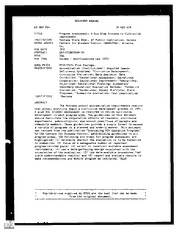
ERIC ED362564: Program Assessment: A Six-Step Process to Curriculum Improvement.
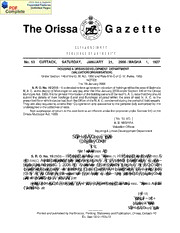
Odisha Gazette, 2006-01-07, No. 53
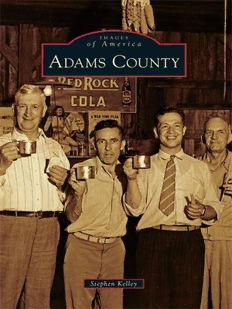
Adams County
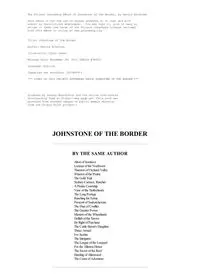
Johnstone Of The Border by Harold Bindloss
![Iceland [1990/1991] book image](https://cdn.pdfdrive.to/media/content/thumbnails/3a76f6bb-280c-4412-ad29-ce45b0511e11.webp)
Iceland [1990/1991]

The Fly Leaf Volume I Number 1 by Walter Blackburn Harte

Cain and Abel My Brothers Keeper
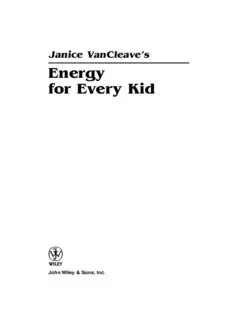
Janice VanCleave's Energy for Every Kid: Easy Activities That Make Learning Science Fun

CALAIS Theo
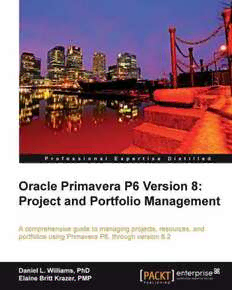
Oracle Primavera P6 Version 8: Project and Portfolio Management

Chhattisgarh Gazette, 2008-01-25, No. 4, Pt. 3 (2)

Sniper · 160 tödliche Treffer

Campbelltown to Mt Annan, Narellan & Harrington Park

NAELACHI LAGVODD
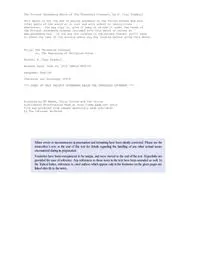
The Threshold Covenant by H Clay Trumbull

